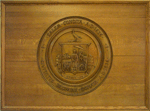Phillips Library
Phillips Library The earliest formal recognition of a library was with the East India Marine Society, founded in 1799. In 1867, the EIMS became the Peabody Academy of Science. Among its formal governing principles was the establishment of “a working library”. By 1915, it became apparent that the PAS had matured from its roots as an academy devoted to science into a museum with broader collecting interests and cultural commitments, thus prompting a name change to the Peabody Museum of Salem. A new corporate seal was adopted depicting the museum's three areas of interest - ethnology, natural history, and maritime history. It was soon recognized that expanded library space was greatly needed and the Stephen Phillips Library was constructed in Plummer Hall (1857) with funds from Stephen Phillips; the reading room was named for the Saltonstall family. In 1992, the Peabody Museum merged with the Essex Institute, combining their respective libraries to form what we now know as the Phillips Library. The collections of the Phillips Library consist of manuscripts, books, pamphlets, maps, charts, photographs and documents created for personal, business, legal, artistic, didactic and scholarly use.
